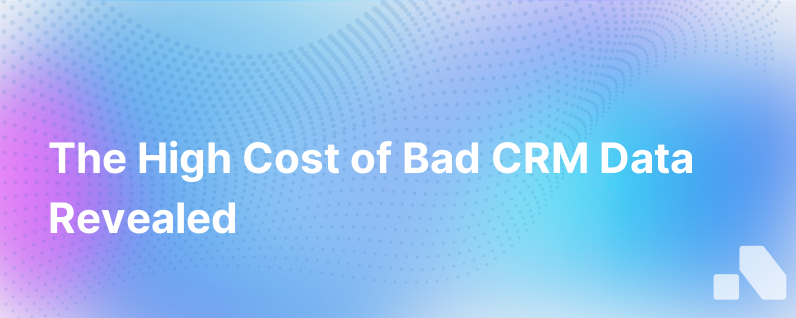Bad Crm Data Can Cost You 10 In Annual Revenue
Published on January 2, 2024 by David Zhang
In the adage, "data is the new oil," lies an unstated warning: just like unrefined oil, unprocessed data is not beneficial—it may even be harmful if mishandled. This holds especially true for CRM data within the business ecosystem. When Customer Relationship Management (CRM) data becomes inaccurate, incomplete, or outdated, it creates a trickle-down effect of inefficiency and unreliability across a business's operations. The cost? Studies suggest that bad CRM data can cost companies up to 10% in annual revenue. Let's uncover the hidden dangers of poor CRM data and explore strategies for safeguarding your bottom line.
The Ripple Effect of Inaccurate CRM Data
CRM systems are designed to streamline operations and enhance customer relations by providing a single source of truth. However, when that source is contaminated with bad data, the consequences are far-reaching:
-
Lost Sales Opportunities: CRM systems are central to lead generation and sales follow-ups. Incorrect data can lead to missed sales opportunities or wasted effort on poorly qualified leads.
-
Impaired Decision Making: Executives rely on CRM data for strategic planning. Bad data can result in misguided strategies that divert resources away from more profitable activities.
-
Diminished Customer Experience: Accurate data is key to personalized customer interactions. Errors can lead to miscommunications and a failure to meet customer expectations.
-
Inflated Operational Costs: Bad data creates extra work—teams must sift through irrelevant information, correct errors, or wrestle with duplicates, leading to increased operational costs.
-
Weakened Trust: Internally, when staff cannot rely on CRM data, trust in the system and in data-driven decision-making weakens. Externally, customers and prospects quickly lose faith in a company that can't manage their information effectively.
Quantifying the Cost of Bad CRM Data
To understand how bad CRM data leads to a 10% loss in revenue, we should examine a few underlying factors:
-
Productivity Declines: Sales productivity takes a hit when reps spend time wrangling bad data rather than closing deals. According to a report by Salesforce, sales reps spend 68% of their time on non-selling tasks, with data management being a significant contributor.
-
Marketing Mishaps: Poor data can sabotage even the best marketing campaigns. An Experian study found that the average company loses 12% of its revenue to inaccurate data due to targeting mishaps and poor customer engagement.
-
Compliance Risks: In the era of GDPR and CCPA, mishandling customer data isn't just inefficient—it's potentially illegal, with hefty fines for non-compliance.
-
Customer Churn: Bain & Co report that a 5% increase in customer retention can increase a company’s profitability by 75%. Conversely, inaccurate data can drive customer dissatisfaction and churn, leading to revenue loss.
The Origins of Bad CRM Data
Understanding the root causes of bad CRM data is pivotal in combating its negative effects:
-
Human Error: Whether it's a mistyped email address or incorrect lead information, manual data entry is prone to mistakes.
-
Silos and Integration Issues: Disconnected systems and poor integration lead to inconsistent data across organizations.
-
Outdated Information: With data decaying at an estimated rate of 2.1% per month according to SiriusDecisions, a failure to regularly cleanse data leads to obsolescence.
-
Lack of Standardization: Without clear data entry and management protocols, data discrepancies become commonplace.
Strategies for Combating Bad CRM Data
Tackling the perils of bad CRM data requires a multifaceted approach:
-
Employ Data Cleaning Tools: Use automated tools to clean and maintain CRM databases regularly. This includes de-duplication, standardizing data entry, and validating data accuracy.
-
Educate Your Team: Training staff on the importance of data hygiene and the practices to maintain it is crucial. Make them aware of the cost of bad data.
-
Leverage Integration Tools: Ensure that your CRM system integrates smoothly with other databases and tools your company uses, keeping data consistent across platforms.
-
Implement Data Governance Policies: Establish clear policies that outline how data should be handled and managed throughout its lifecycle.
-
Regular Data Audits: Schedule periodic audits of your CRM data to evaluate its health and identify areas for improvement.
-
Feedback Loops: Create mechanisms for sales, marketing, and customer service teams to provide feedback on data quality issues they encounter.
-
Adopt Predictive Analytics: Utilize advanced analytics to identify trends that may indicate data issues, such as sudden drops in engagement or unexpected customer behavior patterns.
The Bright Future of CRM Data Management
Turning around bad CRM data is not an overnight fix, but with deliberate actions, the change can be transformative. Investing in data quality tools and processes may appear costly at first, but compared to the 10% revenue leak it plugs, it's a wise investment. Also noteworthy is the emerging role of AI in CRM data management, where predictive models and machine learning algorithms are starting to offer remarkable capabilities in maintaining data accuracy and utility.
In summary, the health of CRM data is inextricably linked to the financial health of a company. To safeguard against the revenue loss of up to 10% annually, vigilant data management should be a cornerstone strategy of any CRM system implementation. Consider solutions like Aomni that intelligently automate data entry and ensure real-time accuracy of CRM data, empowering businesses to make well-informed decisions, optimize their operations, and ultimately preserve their bottom line.